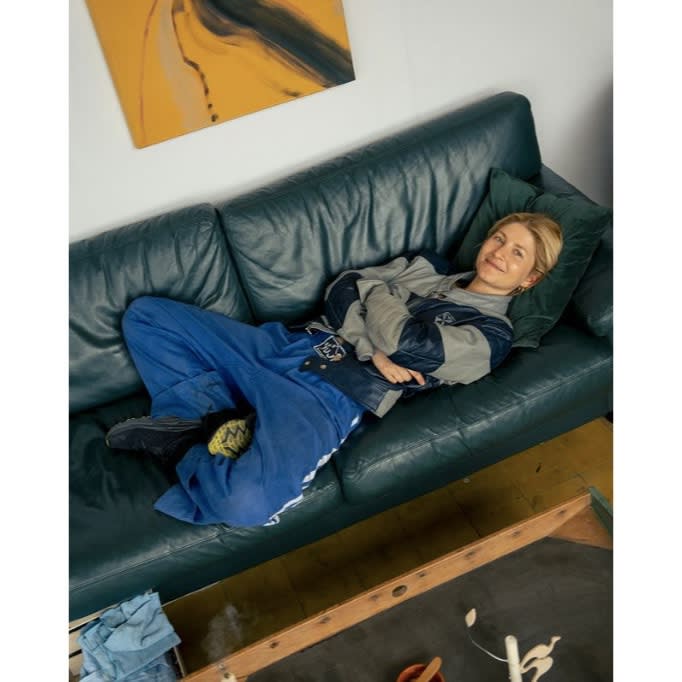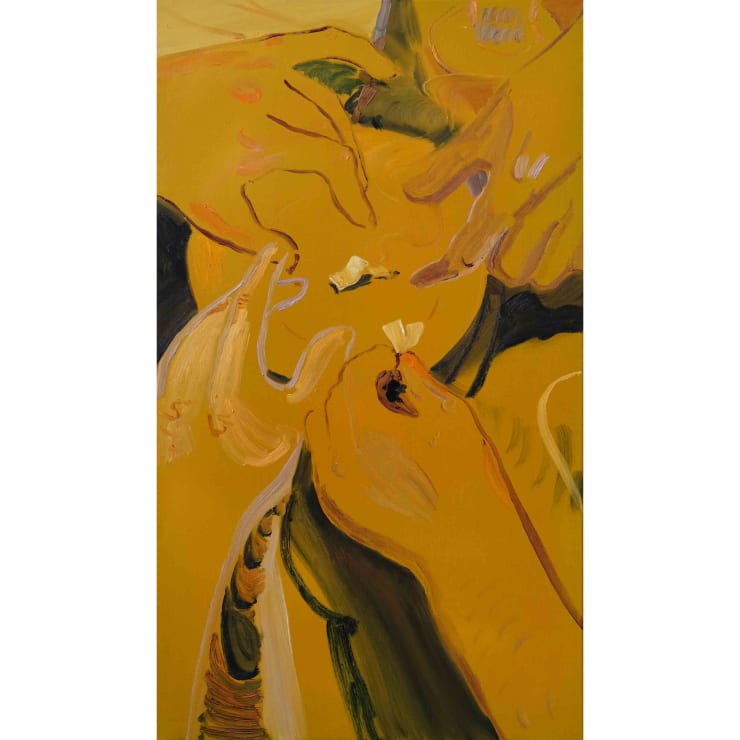Words have become a core part of Anna van der Ploeg’s practice. Anna’s articulate, poetic and often surrealistic titles enhance the mystery of her compositions, extending the narrative beyond the canvas. Ahead of the exhibition, Anna invited writer and friend Lucienne to co-author this new body of work. After sending Lucienne a sequence of prompts, which included perspective titles, phrases and several images, the writer replied with a constellation of associations, digressions, and oblique reflections that accompanied each work.
The exhibition takes it’s titled from this exchange between the artist and Lucienne. Fourteen envelopes addressed to Lucienne is centred around the idea of a game; people gathered at a table express their tribulations, excitement and anger through the gestural expression of their hands, fingers and feet. For Anna, the ‘game’ is seen as an invitation for chance, constraints, and chaos.
Below is a series of correspondence between two friends: a series of fourteen envelopes and responding words.
Dear Anna,
Thank you for this invitation and these envelopes. In return, as requested: words, associations –
(I hope you are feeling very much recovered after the accident)
Love,
Lucie
1.
Two vessels – a jug, a bucket. Then: the necessary problem of description.
Red-ribbon lines, fresh blood in porcelain sink
Adjectives, the poet writes, “are the latches of being,” syntactical mechanisms that attach “everything in the world to its place in particularity.” (1) Fastening, delineating.
Red-ribbon, fresh, even porcelain.
Can a painting that is russet be grey-hazed be bitter be warm be luminescent be muddy?
To what particularity should it be bound?
How to settle on a latch?
2.
Adjectives accumulate on so many slips of paper.
Resist description. Pursue instead: a grammar of colour.
The nature of the writing has changed.
Then – simmer.
3.
Hands, those dextrous instruments, so good at unlatching, prising, parting.
Parsing, as one does a sentence –
as if I had words instead of fingers, or fingers at the tip of my words (2)
4.
I think of your bruises and your probing fingers feeling the new contours of a damaged jaw. Feeling: blooms of spreading indigo lighten to sour yellow. Feeling: tenebrous swelling. Knowing: here is break. The colour of marrow; a compound adjective, double-edged latch –
5.
Not maroon nor burgundy nor scarlet. Not vermillion. In the bone, darker. On your canvas, dusty heat when the wind picks up. Which is to say:
Not words – but shades. (3)
6.
For the verb spit, two hues: chartreuse (poison, danger, intoxicant), crimson (blood, warmth, an excess). A flooding of the mouth; bitter sting, metallic heat. Spit. Into the porcelain sink from earlier; bright against impassive white.
7.
A note you wrote on baking paper,
tucked in a borrowed book –
Like eating a meal in the dark.
Burnt steak sienna. Raw cake-batter umber.
8.
What else can be dissolved?
Blind colours like taupe, named for a mole. Subterranean claustrophobic scrabbling brown. Unseeing brown, taupe between the teeth. Dirt in your mouth. Dirt in your mouth in the dark brown.
(Only not your mouth, broken as it is, madder wet and sore scarlet)
9.
Stew, you say now – where first you said, simmer.
Intended here as a noun; the other, an elongated action (nothing simmers briefly). Stew too is a stretched-out word. Carrots, onions, celery, once-pink-living meat, time, patience –
slowly now.
Don’t sleep; wouldn’t dare. Not with a pot on the stove. In all this cadmium yellow.
10.
“Red protects itself,” the artist writes. “No colour is as territorial. It stakes a claim, is on the alert against the spectrum.”
Then –
Vino Santo. Vino rouge. Plonk. Shut your inebriate eyes and see red forever after. (4)
11.
Breaking, broken.
What do you mean by rule?
This isn’t a game, no – closer to riddle, closer to labyrinth, closer to getting lost.
12.
Green metre squared. Thick, weirdly stubborn colour. Obstreperous. A 7 p.m. colour. A two-men-talking-in-the-study colour. Easy drinkable claret and some senior gripping my wrist colour. Hate to admit it, English colour.
Green against cream.
Racing green, dated green, belatedly worked out how to dilute the paste and fill the cut-circle space with it: green. (5)
Against the stubborn colour, another: butter rancid yellow cuts of speculative flesh.
13.
Words reach – as hands do. Writing is an exercise in degrees of proximity. The sentences move closer, circling their painted subject. Imprecision, generalities, vague words (there are no vague colours). Not even mauve, that ambivalent tone, or gamboge, which sounds brown but isn’t.
Feint, retreat.
Find instead: similes, approximations, likenesses –
here everything was condensed, impacted, mired.
The paintings were like an ugly mood. (6)
Here everything is close, convivial, quiet conversation.
Like a game played to obscure rules –
low sound of voices heard through the wall paintings.
14.
Feeling fingers working at the screws of latches. Contranyms, those Janus words: bolt, fast. To flee, to fix in place; to move rapidly, to hold steady. Wire the jaw shut, bind the colour to its particularity.
What work?
Enough now. The slippery shades, let them slide.
For no one really knows what colour is, where it is, even whether it is. (Can it die? Does it have a heart?)
Later –
The blue was beating. (7)
(1) Anne Carson, Autobiography of Red (1998)
(2) Roland Barthes, A Lover’s Discourse: Fragments (1977)
(3) Ocean Vuong, On Earth We’re Briefly Gorgeous (2019)
(4) Derek Jarman, Chroma (1994)
(5) From the borrowed book: Max Porter, The Death of Francis Bacon (2021)
(6) Janet Malcolm, Forty-One False Starts: Essays on Artists and Writers (2013)
(7) Maggie Nelson, Bluets (2009)
Fourteen Envelopes Addressed to Lucienne will be on display until 29 September 2023.
September 7, 2023



